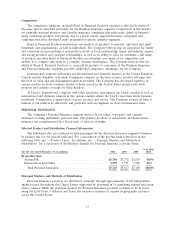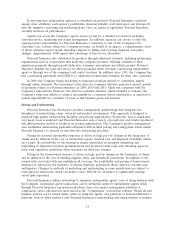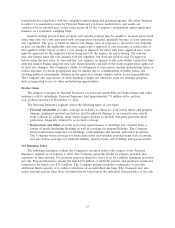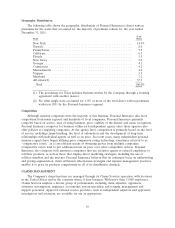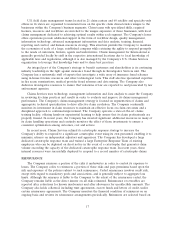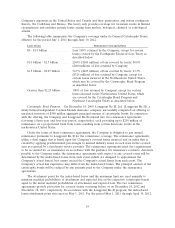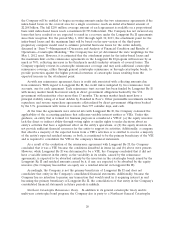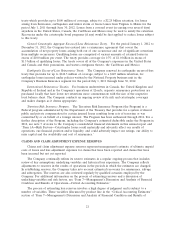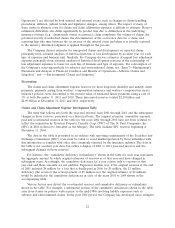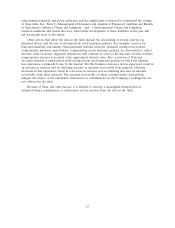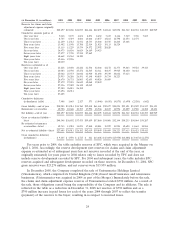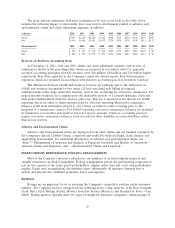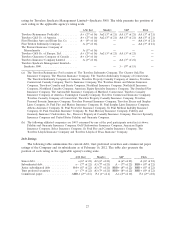Travelers 2011 Annual Report Download - page 30
Download and view the complete annual report
Please find page 30 of the 2011 Travelers annual report below. You can navigate through the pages in the report by either clicking on the pages listed below, or by using the keyword search tool below to find specific information within the annual report.their financial condition, business practices, the price of their product offerings and the value of
collateral provided. After reinsurance is purchased, the Company has limited ability to manage the
credit risk to a reinsurer. In addition, in a number of jurisdictions, particularly the European Union
and the United Kingdom, a reinsurer is permitted to transfer a reinsurance arrangement to another
reinsurer, which may be less creditworthy, without a counterparty’s consent, provided that the transfer
has been approved by the applicable regulatory and/or court authority. For additional information
concerning reinsurance, see note 5 of notes to the Company’s consolidated financial statements and
‘‘Item 1A—Risk Factors.’’
The Company utilizes a variety of reinsurance agreements to manage its exposure to large property
and casualty losses, including:
• facultative reinsurance, in which reinsurance is provided for all or a portion of the insurance
provided by a single policy and each policy reinsured is separately negotiated;
• quota share reinsurance, in which reinsurance is provided for an agreed-upon fixed percentage
of liabilities, premiums and losses for each policy covered on a pro rata basis;
• treaty reinsurance, in which reinsurance is provided for a specified type or category of risks; and
• catastrophe reinsurance, in which the Company is indemnified for an amount of loss in excess of
a specified retention with respect to losses resulting from a catastrophic event.
For a description of reinsurance-related litigation, see note 15 of notes to the Company’s
consolidated financial statements.
Included in reinsurance recoverables are certain amounts related to structured settlements, which
comprise annuities purchased from various life insurance companies to settle certain personal physical
injury claims, of which workers’ compensation claims comprise a significant portion. In cases where the
Company did not receive a release from the claimant, the amount due from the life insurance company
related to the structured settlement is included in the Company’s consolidated balance sheet as a
liability and as a reinsurance recoverable, as the Company retains the contingent liability to the
claimant. In the event that the life insurance company fails to make the required annuity payments, the
Company would be required to make such payments, if and to the extent the purchased annuities are
not covered by state guaranty associations.
Catastrophe Reinsurance
Catastrophes can be caused by a variety of events, including, among others, hurricanes, tornadoes
and other windstorms, earthquakes, hail, wildfires, severe winter weather, floods and volcanic eruptions.
Catastrophes can also result from a terrorist attack (including those involving nuclear, biological,
chemical or radiological events), explosions, infrastructure failures or as a consequence of political
instability. The incidence and severity of catastrophes are inherently unpredictable. The extent of losses
from a catastrophe is a function of both the total amount of insured exposure in the area affected by
the event and the severity of the event. Most catastrophes are restricted to small geographic areas;
however, hurricanes and earthquakes may produce significant damage in larger areas, especially those
areas that are heavily populated. The Company generally seeks to manage its exposure to catastrophes
through individual risk selection and the purchase of catastrophe reinsurance. The Company utilizes a
general catastrophe reinsurance treaty with unaffiliated reinsurers to manage its exposure to losses
resulting from catastrophes. In addition to the coverage provided under this treaty, the Company also
utilizes a catastrophe bond program, as well as a Northeast catastrophe reinsurance treaty, to protect
against certain losses resulting from catastrophes in the Northeastern United States.
General Catastrophe Reinsurance Treaty. The general catastrophe reinsurance treaty covers the
accumulation of net property losses arising out of one occurrence. The treaty covers all of the
18







